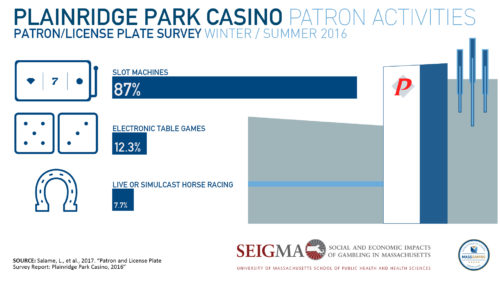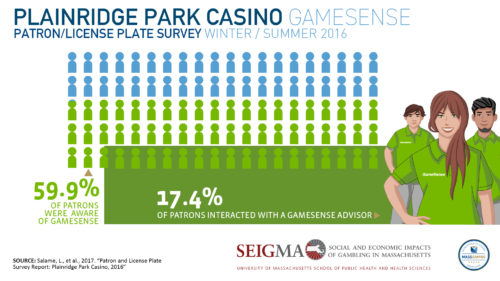Research Update: Plainridge Park Casino Patron Survey Results shared with MGC
- October 26, 2017
- by MGC Communications
- 0 comments
UMass Amherst research team finds most casino patrons visited Rhode Island and Connecticut casinos prior to Plainridge opening
AMHERST, Mass. – Today researchers at the University of Massachusetts Amherst, who are conducting a multi-year, comprehensive study known as the Social and Economic Impacts of Gambling in Massachusetts (SEIGMA), reported results of their first patron survey to the Massachusetts Gaming Commission (MGC) at its meeting in Boston.
Along with a license plate survey, the patron survey was conducted in 2016 at Plainridge Park Casino (PPC), the state’s first casino, which opened in June 2015. Laurie Salame, senior lecturer at UMass Amherst’s Isenberg School of Management, led the patron survey and is the lead author of this report.
Rachel Volberg, professor of epidemiology at UMass Amherst’s School of Public Health and Health Sciences and a lead SEIGMA researcher, says, “The survey is a tool that allows us to collect data from patrons about where they come from and how much they spend, which is important for understanding the economic impacts of the casino.”
Salame, Volberg and colleagues found that nearly 90 percent of PPC patrons had visited casinos in other states in the year prior to the opening of PPC with the majority, 72.3 percent, having visited casinos in Connecticut and 55.9 percent in Rhode Island. The majority of PPC patrons were from Massachusetts, with 11.4 percent from Plainville or nearby towns and another 66.5 percent from other Massachusetts communities. Overall, 19.2 percent of patrons were from outside the Commonwealth.
The research team also reports that compared to the general adult Massachusetts population, PPC patrons were older, somewhat more likely to be white, more likely to have higher education and an annual household income between $50,000 and $100,000.
In addition to its existing horse race betting, PPC now offers 1,250 slot machines including several electronic table games. The report states that most patrons, 87 percent, played the slot machines while a much smaller number, 12.3 percent, played electronic table games, and just 7.7 percent bet on live or simulcast horse racing.
As the authors explain, asking patrons directly about their gambling and non-gambling spending during casino visits helps to better understand the economic impacts of new gambling establishments, including what is “new” spending and what is “recaptured” from casinos in neighboring states. “Recaptured” patrons are Massachusetts residents who would have spent their money at an out-of-state casino and “reallocated” patrons are Massachusetts residents who would have spent their money on other goods and services in the state had PPC not opened. The research team estimates that over half of all gambling, 58.3 percent, and non-gambling, 50.4 percent, spending by Massachusetts patrons at PPC is “recaptured.” An additional 16.3 percent of gambling spending by Massachusetts residents was “reallocated” from other goods and services.
Mark Melnik, director of the UMass Donahue Institute’s Economic & Public Policy research group and a lead SEIGMA researcher, says that as a result of the survey, researchers gained “critical insights into PPC patron behavior” that otherwise would have been impossible. “Perhaps most notably,” he adds, “we were able to use the survey results to estimate that the majority of the money spent at PPC would have been spent out of state if gambling had never expanded in Massachusetts.”
Residents of the Greater Boston area, which includes Plainville and several surrounding communities, account for the majority, 49.7 percent, of recaptured gambling spending and 66.4 percent of recaptured non-gambling spending at the casino. Most of the remaining recaptured spending is accounted for by residents in the Southeast region.
The 2016 survey of 479 patrons took 5 to 10 minutes to complete and was carried out by teams of undergraduate UMass Amherst students who used a questionnaire developed by the full research team. Salame and co-authors point out that they went to great lengths to capture a representative sample of patrons. This required researchers to survey patrons in winter and summer and during peak and non-peak days and times.
MGC Commissioner Enrique Zuniga said, “This type of rigorous research provides remarkable insight into the gambling and non-gambling expenditures of casino patrons. The gaming law requires a robust research agenda to analyze the social and economic impacts of the state’s gaming industry. No other gaming commission in the country has this type of information at their fingertips to inform policy and make data-driven decisions.”
A small number of questions in the survey asked about respondents’ experiences with GameSense, the responsible gambling educational program required by the Massachusetts gaming law, Volberg notes. The report finds a high awareness of the GameSense program, 59.9 percent of patrons. Among patrons with an awareness of GameSense, 17.4 percent reported interacting with a GameSense Advisor. Among this group of patrons, 98.6 percent were satisfied with the information offered by the GameSense Advisor and one in four, 24.7 percent, changed the way they gambled as a result.
An associated license plate survey estimated that 82.9 percent of overall gambling and non-gambling revenue was derived from Massachusetts residents, “which is close to the 79.1 percent calculated by the more precise Patron Survey. Thus, the License Plate Survey lends support to previous estimates of out-of-state Massachusetts casino expenditures reported by the Northeastern Gaming Research Project,” it adds.
View the full report.
Contact: Janet Lathrop, 413/545-0444; jlathrop@admin.umass.edu
Rachel Volberg, 413/545-6700; rvolberg@schoolph.umass.edu
Elaine Driscoll, Massachusetts Gaming Commission, 617/571-2964; elaine.driscoll@state.ma.us


